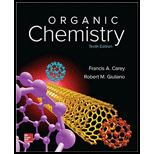
ORGANIC CHEMISTRY (LL)-W/SOLN.>CUSTOM<
10th Edition
ISBN: 9781259972348
Author: Carey
Publisher: MCG CUSTOM
expand_more
expand_more
format_list_bulleted
Question
Chapter 11, Problem 45P
Interpretation Introduction
Interpretation:
The product for each of the given compounds undergoing intramolecular Diels -Alder reaction is to be given.
Concept Introduction:
The Diels-Alder reaction is the conjugate addition of an
The two double bonded carbon atoms in the dienophile constitute two possible sites of reaction.
The reaction occurs in one step without forming an intermediate.
The product of a Diels-Alder reaction always contains one more ring than the reactants.
In intramolecular Diels-Alder reaction, a molecule has three double bonds and two of them are conjugated.
Expert Solution & Answer
Want to see the full answer?
Check out a sample textbook solution
Students have asked these similar questions
When heated, allyl aryl ethers and allyl vinyl ethers undergo a reaction called a Claisen rearrangement, a concerted reorganization of bonding electrons similar to the Diels-Alder reaction. The reaction proceeds through a six-membered, cyclic transition state.
Draw the structure of the expected product when this compound undergoes a Claisen rearrangement.
You do not have to consider stereochemistry.
For the purposes of this problem, assume that double bonds in an aromatic ring are localized at the positions indicated in the figure.
Include isomerization to a phenol IF appropriate.
Intramolecular Diels–Alder reactions are possible when a substrate contains both a 1,3-diene and a dienophile, as shown in the following general reaction.With this in mind, draw the product when each compound undergoes an intramolecular Diels–Alder reaction.
A transannular Diels–Alder reaction is an intramolecular reaction that occurs when the diene and dienophile are contained in one ring, resulting in the formation of a tricyclic ring system. Draw the product formed when the following triene undergoes a transannular Diels–Alder reaction.
Chapter 11 Solutions
ORGANIC CHEMISTRY (LL)-W/SOLN.>CUSTOM<
Ch. 11.1 - Prob. 1PCh. 11.1 - Prob. 2PCh. 11.2 - The two compounds shown differ by a factor of 60...Ch. 11.2 - Prob. 4PCh. 11.2 - Prob. 5PCh. 11.2 - Prob. 6PCh. 11.3 - Prob. 7PCh. 11.3 - Prob. 8PCh. 11.3 - Evaluate 2,3,3-trimethyl-1-butene as a candidate...Ch. 11.4 - After heating a solution of allyl tert-butyl...
Ch. 11.5 - Prob. 11PCh. 11.6 - Prob. 12PCh. 11.8 - Prob. 13PCh. 11.9 - What dienes containing isolated double bonds are...Ch. 11.10 - Prob. 15PCh. 11.10 - Prob. 16PCh. 11.11 - Prob. 17PCh. 11.12 - Dicarbonyl compounds such as quinones are reactive...Ch. 11.12 - 2,3-Di-tert-butyl-1,3-butadiene is extremely...Ch. 11.12 - Methyl acrylate (H2C=CHCO2CH3) reacts with...Ch. 11.13 - Prob. 21PCh. 11.14 - What diene and dienophile could you use to prepare...Ch. 11.14 - Write equations in the synthetic direction for the...Ch. 11.16 - Prob. 24PCh. 11.16 - Prob. 25PCh. 11 - Write structural formulas for each of the...Ch. 11 - Give an acceptable IUPAC name for each of the...Ch. 11 - A certain species of grasshopper secretes an...Ch. 11 - Which of the following are chiral?...Ch. 11 - Describe the molecular geometry expected for...Ch. 11 - Prob. 31PCh. 11 - What compound of molecular formula C6H10 gives...Ch. 11 - Prob. 33PCh. 11 - Prob. 34PCh. 11 - Prob. 35PCh. 11 - Prob. 36PCh. 11 - Identify the more reactive dienophile in each of...Ch. 11 - Prob. 38PCh. 11 - Prob. 39PCh. 11 - Prob. 40PCh. 11 - Prob. 41PCh. 11 - Prob. 42PCh. 11 - Prob. 43PCh. 11 - Prob. 44PCh. 11 - Prob. 45PCh. 11 - Prob. 46PCh. 11 - Show how to prepare each of the following...Ch. 11 - Prob. 48PCh. 11 - Prob. 49PCh. 11 - Prob. 50PCh. 11 - Compound A was converted to compound B by the...Ch. 11 - Suggest reasonable explanations for each of the...Ch. 11 - Prob. 53PCh. 11 - Prob. 54PCh. 11 - Prob. 55DSPCh. 11 - Prob. 56DSPCh. 11 - Prob. 57DSPCh. 11 - Prob. 58DSPCh. 11 - Prob. 59DSP
Knowledge Booster
Similar questions
- The A ring of cortisone (a steroid) is formed by a Diels–Alder reaction using the two reactants shown here. What is the product of this reaction?arrow_forwardThe transformation takes place via two sequential pericyclic reactions. Identify the two reactions and give a critical explanation whether the reactions are allowable or not. Explain the stereochemistry.arrow_forwardShow how the following starting material is converted to the given product by a series of two pericyclic reactions. Account for the observed stereochemistry.arrow_forward
- Which of the following compounds reacts most rapidly in a halogenation reaction?arrow_forwardShow how the following starting materials are converted to the given product by a series of two pericyclic reactions. Account for the observed stereochemistry.arrow_forwardwhat is the structure of the substitution product in the following reaction and consider stereochemistry in deciding your product?arrow_forward
- Which alkene product would you expect to be the major product under kinetic conditions? Under thermodynamic conditions? The given pictures are the reactions in which we have to determine which alkene product we expect would be the major product under kinetic and thermodynamic conditions.arrow_forwardDraw the major products obtained from the reaction of one equivalent of HBr with the following compounds. For each reaction, indicate the kinetic product and the thermodynamic productarrow_forwardThe following product is formed by an intramolecular Diels-Alder reaction. Provide the structure of the starting compound.arrow_forward
- Draw the products of the following Diels–Alder reactions. Indicate stereochemistry where appropriate.arrow_forward2) Rank the following dienes by how rapidly they will undergo Diel-Alder reactions with ethylene.arrow_forwardIdentify the following pericyclic reaction; explain the course, product distribution and stereochemistry of the reaction. Where the first product is produced 70% and the second product is produced 30%.arrow_forward
arrow_back_ios
SEE MORE QUESTIONS
arrow_forward_ios
Recommended textbooks for you
